It takes a lot to keep social media ads performing these days. While budget, audiences, and account strategy can all have an impact, the biggest driver of success (or failure) is your ad creative. And the secret to having winning ad creative is to test a lot of it.
There are several ways to test your social media ads, making it hard to strike the right balance between launching new “big idea” ads vs. small tweaks, or iterations, of those big ideas. Thankfully, we’ve found a method that helps us find winning ads fast. We call it the Outlier Method.
The Outlier Method
At Primer, we have a simple, four-step approach for our creative tests that allows us to launch dozens or even hundreds of high-quality social media ads per month:
- LAUNCH: Ideate and launch “big idea” ads based on key questions buyers have. (Get our step by step guide on ad testing here.)
- PAUSE: Pause underperforming ads and determine the ads that beat the account average and become top performers — the “wins” — we call these the Outliers.
- SCALE: Scale the budget for the “wins” and make creative iterations on them for your next test.
- REPEAT: Periodically start a new “big idea” process and repeat steps 1-3. We do this 1-2 times per month for our partners.
With this method, it is easy to launch dozens or even hundreds of ads per month. In this article, we’ll define big ideas and iterations, explain why they’re important, and show you how to leverage both for your social media advertising.
Step 1: LAUNCH
What is a “big idea” in advertising?
For social media ads, a big idea is a brand new idea, theme, or creative style. Generally, for every big idea, you should create 3-10 ads and launch them into one combined “big idea test.” This is also sometimes called research and development, or R&D, testing.
How to create big ideas in paid social ads
When brainstorming big ideas, focus on concepts that do any one (or a combination) of the following:
- Emphasizes a totally different value proposition than your past tests
- Targets a different audience (e.g. change what gender or age range you’re targeting)
- Uses a fresh visual look
- Includes all-new copy and headlines
- Is part of a larger, new “campaign” (e.g. ads that correspond with your brand’s current influencer campaign)
Make sure your ideas are grounded in your buyer personas. Once you determine your ideal buyer, you can then figure out what types of questions they would ask before purchasing. (Tip: Use our easy buyer decision question worksheet to figure these out for your brand.)
These “buyer decision questions” should guide your copy, headlines, calls-to-action, and more.
Resources for creating high-quality ad creative that converts
When you create new paid social creative, you have the opportunity to try a new style or new content for any of the following ad elements. Below, we’ve linked to a few of our free templates so you can hit the ground running sooner:
- Copy
- Static Imagery
- Image Headlines
- Facebook and Instagram Videos
- TikTok Videos
- Calls to action (CTAs) — See a full list of Facebook calls-to-action and a full list of TikTok calls-to-action
- Headline — This is usually a compelling value prop framed as a next step (e.g. Get 15% Off Now)
- Video thumbnails
- Landing pages
An example of a big idea test
For our partner, Farmstead, we wanted to test an idea that visually shows how much value a customer would get by using Farmstead’s grocery delivery service. For this test, we created 9 images and GIFs, each taking a slightly different approach to the concept.
https://goprimer-1.wistia.com/medias/0xcu36l0w3?embedType=async&videoWidth=381
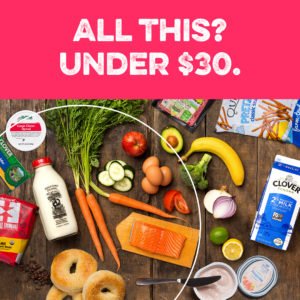 |
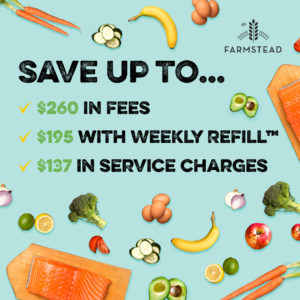 |
Step 2: PAUSE
Within 48 to 72 hours after you launch, you should start making adjustments to the ads within your test. Quickly pause the ads that are underperforming in order to focus on the wins. (Don’t sleep on this – you don’t want to waste money on poor performers.)
Find the wins. A “win” is a top-performing ad that is a performance outlier. Wins should have better performance than your account average by at least 10%. They should also have at least 10 conversions.
After figuring out which ads for a test are wins, you can then move on to step 3: SCALE.
Step 3: SCALE
Now that you have identified your winners you can increase the ad spend to the wins and then start to scale. The fastest way to scale is to create at least 3 ad creative iterations on your winning ads
What is an iteration?
An “iteration” is a variation of your previous top-performing ads (i.e., “wins”) in which you change one or two elements. By creating multiple iterations and testing those, you can thoughtfully scale your account’s wins.
By reusing key elements from past top-performing ads, you can also hone in on what really makes an ad work.
For example, let’s say we have an ad with the same image but a bunch of different headlines.
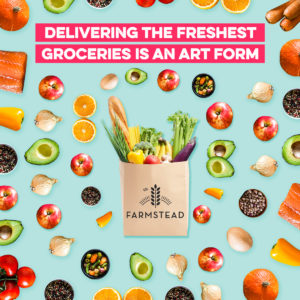 |
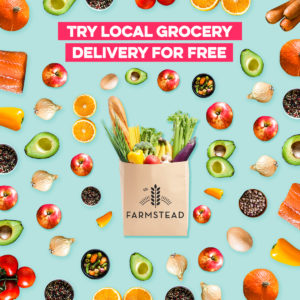 |
 |
If multiple versions of that ad (with those different headlines) perform, it’s likely that something about the main image is leading to increased conversions.
Once you have a top performer, iterations can help refine performance. Over time, you’ll be able to combine multiple winning elements from different ads (say, one top performer’s headline and another’s image) into a new Franken-ad.
 |
Since each element has been proven to work multiple times over, you should see even better performance when combining them all together.
Tip: For every win, create at least 3 iterations. Focus on changing 1 or 2 key aspects of the ads (see a full list of what to test below).
How to create good iterations
Ways to iterate on landing page wins:
- Change the header section at the top of the winning landing page. You can include a new header/hero image, new headline, and a new subhead
- Include a different call-to-action on your buttons
- Swap sections of the landing page around
- If you have a testimonial section, change which testimonials are there
- Keep the copy the same but change the landing page’s images
- Test a longer or shorter version of the page
- Test out a different signup or purchase flow after your button click
- (If applicable) Swap which product you feature
- (If applicable) Change what audience you’re focusing on (e.g. a women-focused page vs. a man-focused page for clothing)
Ways to iterate on video wins:
Select one or two core elements to test and change within your winning video, such as:
- Different testimonials
- Different call-to-action
- Different first frame
- Different thumbnail
- Change the order of the sections within the video (e.g. swap order of price and UGC sections)
- Keep the captions the same but swap the background imagery for something new
- Keep everything the same but swap for a new color scheme
Ways to iterate on image or GIF wins:
Select one or two core elements to test and change within your image/GIF, such as:
- Keep the copy the same but change the main image
- Keep the main image the same but change the main headline
- Change the call-to-action
- Add animation if there is none
- Change animation to static
- Add or swap the background music
- Try the same image with a different color scheme
How we used the big idea and iteration process to scale Farmstead

Step 4: REPEAT
Keep this process going. As you continue to find wins, iterate on those wins. Then, depending on your budget, you should also launch new big ideas 1 – 2 times per month. This continuous pipeline of new tests ensures that your ad account is never going stale and that you always have ads that can support more budget.
Ready to find some big wins?
Altogether, this method significantly and rapidly expands both the number of ads you’ve launched and the advertising spend you’re putting towards proven top-performers. It allows you to spend with a clear strategy for growth rather than wasting money on a series of mediocre, big idea tests.
If you’re ready to try out our Outlier method, you can D.I.Y. with the help of our step-by-step guide to ad testing for social media ads. In it, you’ll find out exactly how often to test, how many ads to test each month, and how to structure your creative testing.
If you’re looking for help scaling and testing your ads, you’ve come to the right place. We’ll handle it all for you – the creative strategy, design, production, reporting, and media buying. You just enjoy the wins.
Just need help producing the creative? Try our new Primer On-Demand platform and get access to a team of expert marketing designers. Make unlimited requests for images, videos and landing pages.
Iconic beauty brand Revlon filed for bankruptcy and has been having a rollercoaster of a week. Whether their stock is up or down, it’s clear that Revlon is not going anywhere, and we have a hunch that their need to meet goals and grow will only become more important.
We feel for you, Revlon. This has probably been a tough week for their marketing team, so we thought we’d help them out.
We applied the Primer method to create a hypothetical campaign, including ad creative and a landing page, that we’re sure would help Revlon drive sales for their ColorStay foundation.
Revlon, here are ads that are sure to acquire more customers. To help create more ads like this, we’ve broken down how and why we made these ads.
Disclaimer: Revlon is not a Primer customer, nor does Primer have any real association with Revlon.
How do we develop an ad strategy for paid social?
When we first partner with a company, we kick off by learning their goals and developing their best customer persona. Then we dig into the most important buying decision questions – these are the answers that their customers HAVE to have before making a purchase. Next, we plug that critical information into key themes we have tested thousands of times over and know will help to generate results.
Since we aren’t actually working with Revlon, we had to take some educated guesses. Here’s what we came up with.
A Best Customer Persona for Revlon
Taylor is a 33-year-old dental hygienist who lives in the suburbs of Chicago. After she graduated from college, she moved to Chicago to live in the city, but as her job has changed, and she has gotten a little older, she has been looking for a little more space that isn’t too far from the action.
Fashion and beauty have always been important to her, but with student loans and rent, she isn’t able to spend as much on her makeup as before. She doesn’t want to trade quality, though, and is looking for the smartest choice in makeup that will still help her look young and trend-forward.
Taylor has tried many makeup varieties, including the trendy, celebrity brands, but with higher gas costs and an increased cost of living, she is looking for ways to save that don’t involve much of a sacrifice.
She wears foundation every day and knows Revlon from the drugstore, but she isn’t sure if it is as high quality as the other brands she has tried. She is about to run out of her current foundation and is looking at alternatives.
Buyer Decision Questions from a Revlon Customer
- Is Revlon a good quality foundation?
- How much does it cost?
- How do I know what it will look like on me?
- Where can I buy it?
- What does it look like on other people?
- Are other people happy with it?
- Is it trendy?
What ideas should we test in paid social?
Once we get a handle on who we’re talking to with our ads, we determine what we are going to say in the ads. This focuses on the key value propositions of the product and addresses those key buyer decision questions above.
At Primer, we’ve tested thousands of ads and through our learning, we have developed several themes that we know are successful at driving conversions for our direct-to-consumer partners. For Revlon, we chose to use the “vs. the competition” theme because we saw that they have faced “increased competition from new brands like those backed by celebrities such as Kylie Jenner’s Kylie Cosmetics and Rihanna’s Fenty Beauty.”
In this theme, we position Revlon’s foundation directly against the competition. In this case, it’s the “trendy, celebrity brand.” Fortunately for us, Revlon has a lot going for it. Here’s what we came up with.
Image Ads That Answer Questions
For our hypothetical ad campaign, we created two images, two videos, and a landing page. Of course, if we were really partnering with Revlon, we would significantly increase the volume of tests we’re running tailored to hit their goals.
This should give them something to get started with.
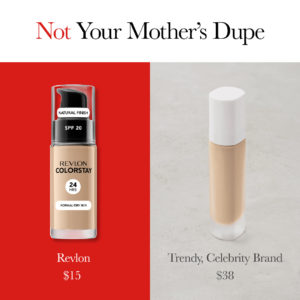
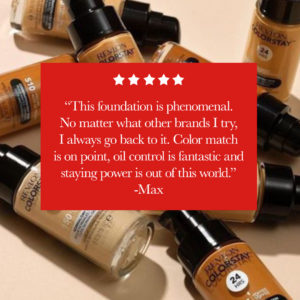
Here’s why these image ads work:
- They directly contrast the Revlon foundation against the “trendy, celebrity brand”
- The headline speaks directly to the target audience using “dupe” and addressing the concept that Revlon could be considered an “old” brand head-on
- The testimonial image gives a great customer quote about having tried other brands and always coming back
- A longer testimonial tends to stop users from scrolling to read a bit more (note: this doesn’t work as well with brand copy, but it does work when it’s a customer talking)
- The five stars visually reinforce the testimonial
As a bonus, we also made them this gif:
https://goprimer-1.wistia.com/medias/2g01hbfbu6?embedType=async&videoWidth=381
Video Ads For Instagram and TikTok
These two video ads are designed to feel native in Instagram and TikTok, positioning Revlon as the trendy foundation that wins over millennials’ hearts and budgets.
| https://goprimer-1.wistia.com/medias/psat1syox4?embedType=async&videoFoam=true&videoWidth=3 | https://goprimer-1.wistia.com/medias/7z2eulr5dx?embedType=async&videoFoam=true&videoWidth=3 |
Here’s why these videos work:
- They are fast-paced, grabbing attention from the first frame
- Trendy, upbeat music feels native to the platform and entices you to keep watching
- Native-style text treatment makes it hard to distinguish if it’s an ad
- Opening copy “hooks” (e.g. Why millennials are switching to Revlon) grab attention
- Keeps Revlon branding to a minimum, again tapping into the organic feel of the platform
- Directly positions Revlon against the competition
A Landing Page Designed to Sell
Landing pages are an often forgotten part of the conversion rate optimization (CRO) process. However, they can hold just as much value as the ads themselves in improving conversions and cost per acquisition (CPA).
It would be so easy for Revlon to run an ad campaign that leads to their website (which is pretty good, we think), but when you pair a landing page with ads that are focused on answering all of those key buyer decision questions, that’s when you find yourself with those smokin’ hot CPAs (the kind that I think the Revlon team would get excited about right now).
So, to help out, we built out a fully functioning Revlon landing page. You can check it out here.

Why this landing page works:
- The landing page continues the “vs. the competition” theme from the ads – what the user sees in the ad is being continued in the landing experience
- User testimonials and press logos validate the quality and trendiness of the product – two core buyer questions
- The page walks you through how you can try on the foundation and make a purchase
- Customer images validate the trendiness and popularity of the product
- CTA buttons are included throughout the page
- The price is included in the CTA button – reinforcing the key value proposition of price in every section
Test More, Win More
We don’t have insights into the real marketing strategy of Revlon, nor do we presume to know the real challenges they face, however, we can see the mountain of opportunity that awaits Revlon ahead. With such a vast consumer base, there are so many testimonials, user images, videos and experiences that can be incorporated into powerful paid social advertising campaigns.
The best way to learn what works is to keep testing.
We hope this inspired you. If you’re looking for more inspiration, we invite you to check out any of these resources:
- Our analysis of Dollar Shave Club’s UGC ads on Instagram
- 10 fashion Facebook & Instagram ads we love right now
- 9 ways to create winning video ads
Looking for more growth marketing help? Primer delivers conversion-focused images, video ads and landing pages within 2 – 4 business days through our On-Demand platform for marketing creative. For brands looking to scale quickly, Primer also offers managed growth marketing services through our full-service agency. To learn more, book a complimentary growth consultation.
As a fast-growing, direct-to-consumer (DTC) business, it can be hard to create static and video ads for paid social that stand out among the competition. Especially if your brand is among the largest DTC category: apparel and accessories.
What Is a Facebook Ad Library? Why Does It Matter to DTC Fashion Brands?
The Facebook ad library is an example of how social media companies like Facebook and TikTok have started compiling ads using their platforms, so they’re searchable by category and can be used to track ad spending data.
We found 10 scroll-stopping ads from top DTC fashion apparel and accessories brands in the Facebook ad library and broken down the winning features so you can apply them to your campaigns today.
Through the process of testing thousands of ads on paid social channels like Facebook, TikTok, and Instagram, Primer has developed its own library, where you can find even more examples of winning ads that are proven to convert and drive growth for your organization.
1. AllBirds – Facebook Video A
What they’re selling: sustainable, lightweight footwear.
The ad:
Why the ad works:
This video ad from the Facebook ad library puts the user in AllBirds’ shoes–literally! The ad achieves this by showing their product in action, avoiding static ad and branding elements, and highlighting some key selling points.
- Shows the shoe in action. We can imagine ourselves running with these shoes more easily because the ad shows not just the shoe in action but also a person putting on the shoes before running in the woods.
- End card with the logo. Instead of a static end card, we see the Allbirds logo flash before a video of the runner.
- Highlights additional selling points in the headline. Allbirds takes advantage of headline and description real estate to share two more reasons to buy: “free shipping + free returns.”
2. Reformation – Facebook and Instagram Image Ad
What they’re selling: eco-friendly, upscale women’s clothing.
The ad:
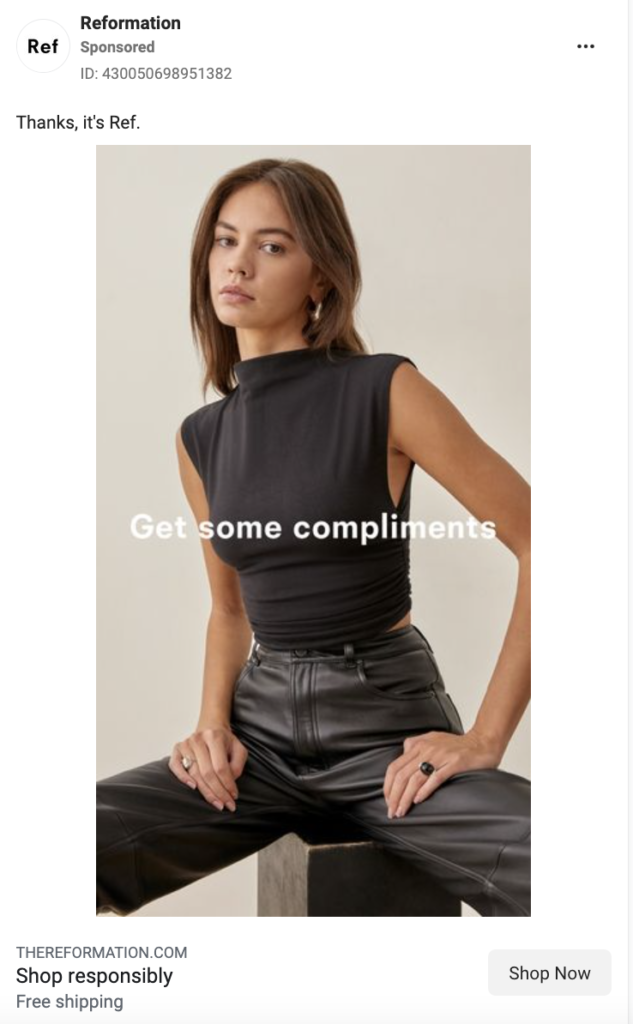
Why the ad works:
We wanted to highlight this image ad by Reformation from Instagram and the Facebook ad library because of its use of selling points in the headline, appeal to buyers’ emotions, conversational tone, and stand-out use of color.
- Highlights additional selling points in the headline. In this instance, “shop responsibly” speaks to sustainability. It subtly positions itself against the competitors (largely fast fashion retailers) with this headline.
- The image headline appeals to buyers’ emotions. “Get some compliments” taps into their buyers’ desire.
- Uses a casual tone in its copy. “Thanks, it’s Ref” achieves a few things for this ad: it allows the brand to speak for itself; it converses with the headline in the image; and it stays true to the brand’s casual, “best friend”-esque tone.
- Plays with color. While most of the “thumb-stopping” ads you’ll find on this list utilize a bright color palette, this ad focuses on having the monochromatic outfit stand out against the bright background of the webpage.
3. StitchFix – Facebook Video Ad
What they’re selling: a personal stylist box.
The ad:
Why the ad works:
- Includes a compelling testimonial in the thumbnail. The user quote serves as social proof of how awesome the service is, and its effectiveness is a perfect example of why this ad makes Primer’s top 10 list from the Facebook ad library. It’s particularly scroll-stopping in a thumbnail because that’s the first thing people see. Continuing the user-generated content (UGC) throughout the video also makes it feel relatable and approachable. Bonus that StitchFix says these are “real clients paid for their time.”
- Shows unboxing footage. Not only is unboxing a current trend on organic social media, but it adds a sense of trustworthiness and excitement.
- Describes the process in easy-to-understand steps. The video breaks down what StitchFix is and how to use it very easily: we learn that you sign up, take a style quiz, and then have clothes picked for you delivered.
4. Pact – TikTok Video Ad
What they’re selling: women’s underwear.
The ad:
Why the ad works:
- Has a person in the first two frames. We’ve found that our best TikTok ads showcase a user in the first two frames. This suits the overall shift to more UGC-style content. Learn more about creating ads that work on TikTok.
- Shows unboxing footage. Pact, like StitchFix, uses unboxing video to complement the rest of their ad. Here, it’s equally successful at making the video seem like a real customer’s journey, and thus being more trustworthy.
- Shows a variety of style options. In multiple frames, we see different color and style options, including in the hand of the narrator, on a screenshot of the website, and laid out one-by-one.
- Has captions (good for both sound on and off viewing). A bonus is that this particular caption style is native to TikTok and reflects TikTok’s “auto-generated” captions.
- Calls out some unique selling points that might appeal to an ideal buyer. (e.g. How Pact’s underwear is sustainable because it’s made from organic cotton.)
5. Alo Yoga – Facebook and Instagram Stories Ad
What they’re selling: workout and athleisure clothing.
The ad:
Why the ad works:
This ad by Alo Yoga earned a top spot in our winning Instagram and Facebook ad library because of how it utilizes urgency, highlights the usefulness of their product,uses simple animation, and makes their ad timely.
- Adds a sense of urgency with “limited edition” messaging. By including “limited edition” in a rotating sticker, this ad not only adds a reason to buy right now (as opposed to later) but also implies an increased sense of exclusivity and competition. It fits with the higher-income audience Alo is likely targeting.
- Shows a full outfit. Matching separates are in right now, and Alo’s ad is not only on-trend, but it also makes their clothing seem more wearable by styling an outfit for buyers right away. They made two versions of this ad: one with a bandaeu top and shorts, and one with a bra top and capris leggings. Tip: Swapping outfits but keeping the rest of your ad the same is a great way to test which product items have the most click-through interest.
- Includes simple motion. One way to stand out from the crowd with your images is to make them GIFs. Here, Alo Yoga takes the static one step further by adding animation to key copy: “blue splash” and “limited edition.”
- Hints at the season in the description. Alo stays relevant to shoppers by including a nod to the current season. Here, we see it in a less prominent location: the description (“So essential for all your summer plans”).
6. Fabletics – TikTok Video Ad
What they’re selling: men’s athleisure apparel.
The ad:
Why the ad works:
- Uses a conversational tone. This ad sounds like a friend talking to you, which makes it seem less like an over-the-top sales pitch.
- Shows the website and different color options. We’ve seen this before: showing the real user experience on a website and the variety of product options entices a variety of buyers and makes your brand seem more legitimate. This ad does something unique, though: instead of just using a screen recording of the website shopping experience, we get a video of the woman actually using the website on her computer. Having her hand in the frame makes this feel like a real user experience.
- Uses native-feeling green screen trend. By utilizing the green screen TikTok filter, this ad feels on-trend and native to the platform. You can also use this filter to keep a person in frame, even when showing off screenshots.
- Has native-style, “auto-generated” captions (good for both sound on and off viewing).
7. Mejuri – Facebook and Instagram Image Ad
What they’re selling: trendy fine jewelry.
The ad:
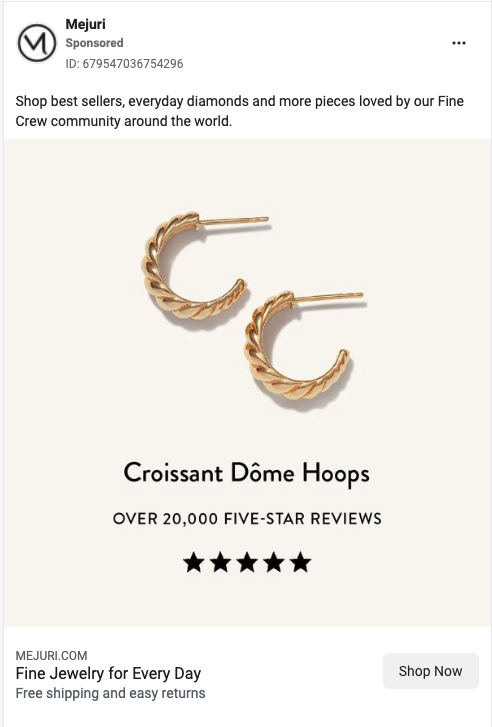
Why the ad works:
- Shows a real number of customers. By including “over 20,000” in their sub-headline, Mejuri makes the positive reviews seem more tangible to potential customers. This is much more impactful versus saying something vague like “Thousands of five-star reviews.”
- Visually shows the stars in the star rating. It may seem like a small thing, but we’ve found that ads that include the stars on the image when talking about the number of positive reviews perform better than those without that same imagery.
- Adds two secondary selling points in the description. They make efficient use of the description space to pack in two more reasons to buy: “free shipping and easy returns.”
8. Rocksbox – Facebook and Instagram Stories Ad
What they’re selling: a jewelry rental subscription box.
The ad:
- *Made by Primer
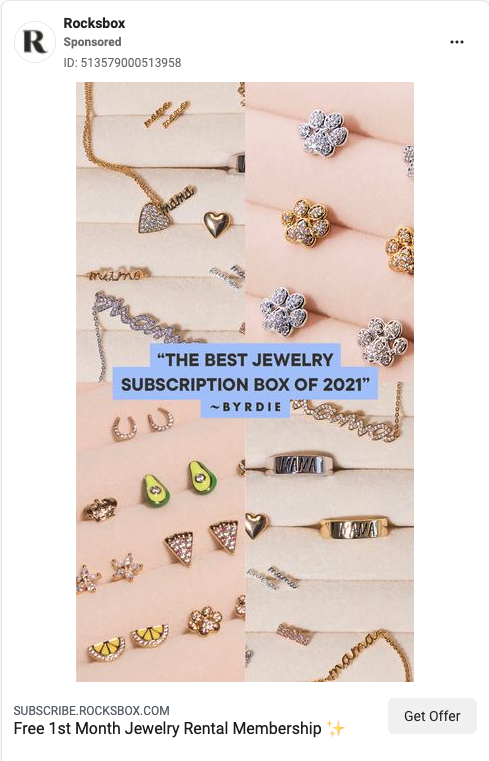
Why the ad works:
This video ad, which Primer made for our long-time partner Rocksbox, deserves a top spot from both Instagram and the Facebook ad library. We’re proud of this ad because it effectively uses press quotes, highlights a variety of product styles, and uses colors that pop.
- Image headline is a press quote. Press quotes, like user testimonials, add a sense of trustworthiness to positive feedback. Here, for example, seeing “the best” feels truer (and less like exaggeration) than if the brand were to claim this themselves.
- Shows a variety of styles. There’s a style that works for everyone, from cute avocado earrings to refined gold chains. By showing a variety of options, you can entice a wider buyer base. People may click on the ad because one specific piece of jewelry caught their eye, and they want to sign up to get it.
- Blue headline background stands out. The sold background color imitates Instagram story captions, while the specific color choice—a bright blue-purple— stands out against the pink background, making the press quote pop.
9. James Allen – TikTok Video Ad
What they’re selling: custom engagement rings.
The ad:
Why the ad works:
- Walks users through the purchase. Videos that follow the “how to” format perform well because they guide the viewer through the buying process and let them know what to anticipate when ordering. This ad walks the user through every step of the process of buying a ring at a specific budget. (More video hooks here.)
- Shows users exactly where to look. Because this video is so jam-packed with information, it uses additional design elements, like arrows and circles to direct attention to the portions of the screen that the voiceover discusses.
- Shows the product on a real hand. After spending so much time on the James Allen website, the ad brings it back to a real person: at the end, they show this DIY’d ring on a real hand.
10. Warby Parker – Facebook and Instagram Stories Ad
What they’re selling: prescription eyeglasses.
The ad:
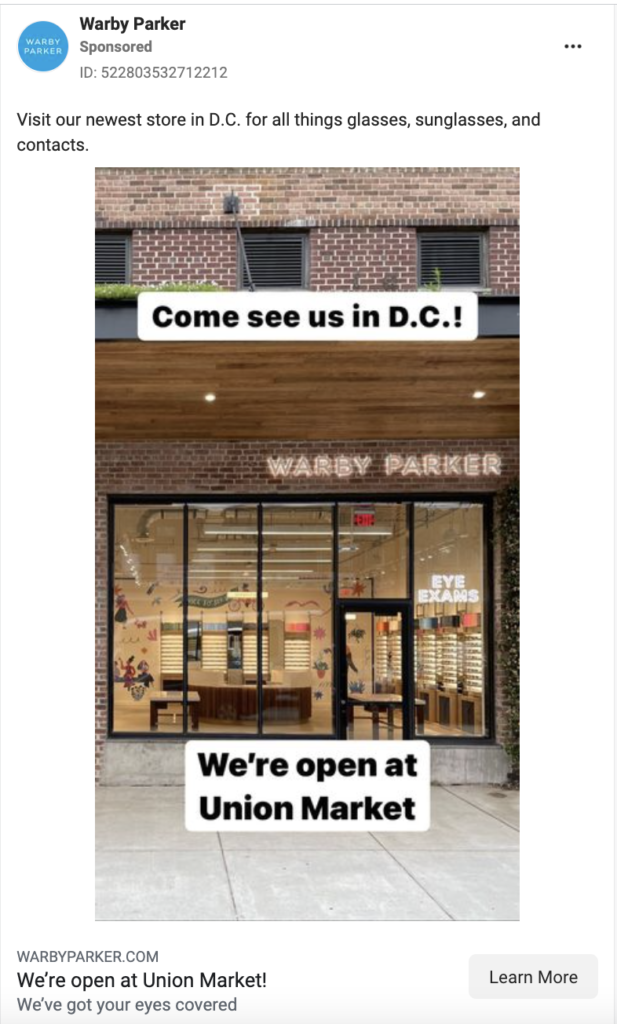
Why the ad works:
- Regional call-out. When your goal is to grow in a specific market or with a specific product, it’s best to filter out unqualified customers by not only targeting the audience but also targeting the content to speak with those you want to reach. This Warby Parker ad creative speaks directly to their target: buyers in D.C.
- Native text style in the image. The black text and white background combination in the image mimics the text style of both Instagram stories and TikTok videos, making this ad feel organic.
What can we take away from these 10 outstanding fashion ads?
Want to create ads that drive conversions, facilitate rapid brand growth, and would be a top performer in the Instagram, TikTok, or Facebook ad library?
Here are 5 rules of thumb for making your content stand out on the feed:
- Include native-style captions and trends to blend more organically into the platform you’re on
- Walk users through the full buyer journey (decision making, after ordering, and unboxing)
- Choose eye-catching, scroll-stopping colors
- Make use of the description to further differentiate your product
- Use your ad creative to target your consumers
Check out more examples of high-converting ads in the Ad Library.
Want to use paid social to stand out from your competition?
Primer works with several DTC apparel and accessories brands, helping them scale their business and hit their goals. If you’re interested in learning how Primer can help you, book a complimentary growth consultation.
You’re probably not launching enough new ads to hit your goals. With changing algorithms and creative styles, it’s more important than ever to refresh your ad creative and unlock new audiences. Here at Primer, we determine how many ads we should test based on the ad spend. We aim for 50 new ads for every $25,000 in ad spend.
Why do we recommend launching 50+ new ads per month?
Testing a high volume of ad creative in paid social helps in four key ways:
- Improves critical metrics like CPA and ROAS
- Keeps ad creative from growing stale (this is increasingly important as converting creative styles change)
- Unlocks new audiences (this is particularly helpful for content-marketing-focused brands
- Leads to a more sustainable growth strategy (Bonus: Consistent testing means you can find wins even as algorithms change)
Won’t testing that much hurt CPA?
Short answer: no.
Using a regular, high-volume testing cadence, we scaled purchase volume by 60% and increasing conversion rate by 65% over a 3-month period for one of our partners.
You can expect a new ad set to increase CPA during its learning phase (right after launching); however, if you structure your test correctly, you can minimize the impact.
Here’s how: create your test in a separate ad set and make sure this testing ad set budget should be less than half of your overall monthly ad spend. This means any spikes in CPA should be both temporary and minor.
In the long run, you’re much more likely to hit your goals with regular testing than by leaving the same two to three ads active for months at a time. This is because of “creative fatigue.” Over time, an ad that was once a strong performer loses its efficiency, and CPAs start to increase. By consistently finding new wins, you can defend your account against this phenomenon and unlock new strategic learnings to use in your future tests, content marketing, email campaigns, and more.
This is particularly true on TikTok, where creative fatigue happens much faster than on Meta.
Here’s what to test in new ads
Launching dozens of ads per month means you should be able to run multiple split tests.
For our purposes, a paid media “split test” means trying out multiple new variations of one element of an ad while keeping everything else the same. And then seeing how those new ads or audiences perform against the old “winner” (i.e. your control ad).
Here are some elements of ads you should test regularly:
- Copy
- Images
- Image Headlines
- Videos
- Calls to action (CTAs)
- Headline
- Audiences
- Video thumbnails
- Landing pages
Try testing out new colors, layouts, phrases, and more. Maybe your audience likes emojis, or maybe they’re more into facts and stats. You won’t know until you try those elements.
How to launch a lot of ad tests fast
(This works for TikTok, Facebook, and Instagram)
Step 1: Set up a new test ad set in your the campaign with your current goal (e.g. Website Purchases)
- For audience tests, use your past top-performing ads with a new ad set audience
- For all other types of tests, use your top-performing audience with new ads within the ad set
- Tip: Make sure you name your ad set so that you can easily tell what it’s testing at a glance. (example: 2022_Purchase_ImageTest_THEME)
Step 2: Launch Ads in Bulk
- Batch together ads in a new test, changing one element (e.g. the copy) and keeping all other elements the same, as a control
- For example, when you test 15 new copy variations, use your top-performing image and audience
- On Facebook, we recommend launching ad sets with 10 – 25 ads in them, though you can go up to 50
- On TikTok, we recommend keeping tests to between 4-6 ads per ad set
Step 3: Set Your Budget
- You want to make sure your budget is high enough that your test can exit the learning phase within 1 – 1.5 weeks. Since the learning phase is generally more expensive, this will help minimize the impact of new launches on your overall CPA.
- For most Facebook campaigns, we recommend using ad set budget optimization (ABO) to have increased control in your test spend. For TikTok, if your budget is under $100k per month, the best option is usually CBO because of the increased creative turnover rates. [Here’s more about setting up TikTok ad campaigns.]
- For Facebook, Instagram and TikTok here’s how much you should spend:
- For ad set budget optimization (ABO): set a daily budget that will yield a minimum of 3x conversions a day with your average CPA
- For campaign budget optimization (CBO): pick a daily budget that ensures you can hit at least 50 conversions per week in the campaign
Step 4: Pause Bottom Performers
- After 48 – 72 hours, you can begin pausing bottom-performing ads (Note: Changes in iOS App Tracking Transparency mean there can be up a 72-hour delay in conversion reporting)
- Pause ads with a higher-than-average CPA
- Continue this process for 1-2 weeks (depending on your budget)
- Once you have 1-4 ads left that either beat the previous period’s average CPA or beat your goal CPA, those are your WINS
Step 5: Scale Wins and Repeat
- First, scale the budget to the wins in the test ad set (for ABO) or campaign (for CBO)
- Then, iterate off of those wins for your next test
- Make sure to keep all elements except what you’re testing the same so you can compare performance between the new ads and the control (i.e., the previous wins)
___
Routinely testing on paid media is the best way to ensure long-term success and growth for your brand. And determining how many ads you should test should be simply based on ad spend.
If the above process feels familiar, it should. At its core, split testing on paid media is grounded in the scientific method.
As you get more information about what performs for your buyer personas (and, perhaps, why), your ads should lead to more conversions from your key audiences and unlock new audiences to expand into.
Still curious about how our methodology works in practice?
See how we launched over 2,200 ads in six weeks for Madison Reed to get them 41% more customers.
Or, book a consultation to get a free growth plan below.
Marketers today face incredible challenges. Technology is changing at break-neck rates. Goals are ever-shifting. The pace to scale your business is faster than ever. And you, the marketer, are held accountable for meeting these ever-changing needs, often without enough resources.
We get it. We’ve been there, and we see it with our partners time and again. You’re strapped for design resources. And engineering resources. Every new martech system seems to require a “simple” integration that still needs some form of decoding from an expert. Your ad accounts need new creative, but your design queue is filled with other priorities.
The one constant among all of this is your goals. No matter what, you need to hit your goals.
Direct-to-consumer brands need to achieve some form of repeatable (and ideally scalable) growth. For our partners, that comes in the form of paid social advertising, but when they come to us, they are often seeing their CACs climb up and have topped out in their ability to scale.
Why? The reason is almost always the same: they are not testing enough.
We’ve crunched the numbers on thousands of video ads, and we know that the first three seconds of your video ad determine whether or not it will perform. These 101 video hooks included below are proven to help boost ad performance on Meta, TikTok, Pinterest, and more. (They even work for organic videos on TikTok and Instagram Reels.)
Price-Focused
- Save time and money with [product]
- Save time and money on [task]
- Is [product] worth it? Let’s see!
- Why is a good [product category] so expensive and hard to find?
- Need affordable [product type]? Watch this!
- How to find affordable [service]
- I can’t believe this only costs [price]
https://goprimer-1.wistia.com/medias/qktdhqh4bk?embedType=async&videoWidth=300
Informative
- What’s in [product]?
- Questions I get about [product]
- Now you can get X delivered to your door
- Thinking about trying [product type]?
- Let me introduce you to [product]
- [category] Tip #X
- Here’s how to get [value prop]:
- I know this sounds crazy but…
- How to get X in just 10 minutes
- How to make time for X
- Let me show you my biggest life hack for X
- Get more [value prop] in your day
https://goprimer-1.wistia.com/medias/jw6zsx58he?embedType=async&videoWidth=300
Versus the Alternative (or Competition)
- Before you try [product type], watch this:
- Hate [the worse alternative]? Try this!
- Thinking about [worse alternative]?
- Instead of doing [worse alternative], try this:
- Still [the worse alternative to the product]? Watch this:
- Something that’s always bothered me about X
- Don’t buy X that won’t work. Instead, try this
- I tried every [product category] so you don’t have to: here’s what I found
- Stop doing [worse alternative]. Try [product]:
- Dealing with [negative experience]? I used [product] to help
- Why millennials are switching to [product]
- How to do X without [worse alternative]
- I ONLY get my [product category] from [brand name]
- I don’t buy my [product category] from [worse alternative]
- [Worse alternative] can be hard to deal with
- Your new X alternative
- [value prop] without the [negative side effect]
- I kept [pain point], so I tried this instead!
- If you [pain point] — you need to see this!
- I wanted to stop doing X, so I tried this instead
https://goprimer-1.wistia.com/medias/s80u45mj6r?embedType=async&videoWidth=300
User Experience
- Guys, it’s here…..
- What I ordered vs. what I got
- [Product] unboxing
- Let’s make X with [product]
- POV: You tried [product]
- A day in the life of X
- Get ready with me to do [task]
- “Put a finger down” [product category] edition
- Trying home remedies to X
- [Product category] ASMR
- My friend said X. So I tried [product]
- My X went from this… to this… with [product]
- Before/After
https://goprimer-1.wistia.com/medias/uk2dcc8ga5?embedType=async&videoWidth=300
Responding to Hype
- TikTok made me try [product]
- Things TikTok made me try #13
- This [product type] is going viral on [social media platform]
- I tested the viral [product type] to see if it lives up to the hype
- This [product type] has over 5,000 reviews… let’s see if it’s worth it
- [Publication] can’t stop raving about us
- So good it sold out in a week
https://goprimer-1.wistia.com/medias/x3tqzlzxhd?embedType=async&videoWidth=300
It’s Easier
- Are you [accomplishing the goal optimally]?
- Life Hack: Try [product] for [pain point]
- My go-to [product] for [pain point]
- How to easily [task]
- [Task] has never been easier than with [product]
- My favorite [product] to make [hard task] easier
- Here’s my favorite product for [task]
- Struggling to do [task]?
- So, I’ve been struggling with [task], but [product] has really helped
- Easiest way to do [task]?
- Make your week easier
- Why adults avoid [task]…. [product] makes it easy
- [Product] made [task] so much easier! You’ve got to try it
- When I use [product], it’s one less thing I have to worry about
https://goprimer-1.wistia.com/medias/e6rilkxh0i?embedType=async&videoWidth=300
Lists
- 5 Ways [product] Helps [pain point]
- 3 reasons to buy [product]
- 3 reasons to try [service]
- Get [value prop] in 3 steps:
- Here are 3 ways [worse alternative] affects your life:
https://goprimer-1.wistia.com/medias/vmekwlunbv?embedType=async&videoWidth=300
The Best
- The internet’s #1 [product type]
- The best way to [accomplish the goal of the product]
- What makes [the product type] the best?
- My skin has never looked better with [product]
- The best way to find X in 2022
- [Product] changed how I do [task], and I’m never going back
- Why is [product] so good though?
- After hours of researching, I found the best [product type] for [task]
- I found the best [product category] for [value prop]
https://goprimer-1.wistia.com/medias/dn1zt20xcb?embedType=async&videoWidth=300
Other Video Hooks that Address Viewers Directly
- Hey, [customer type], you’ve got to try this
- People looking for [product category], stop scrolling
- Wait, have you tried X?
- Take control of your X with [product]
- Imagine if X was also X
- Watch this if you X
https://goprimer-1.wistia.com/medias/jmy0r6ft85?embedType=async&videoWidth=300
Facts & Stats
- PSA: [statement about product category]
- Did you know? [fact about product category]
- I just found out [fact about product category]
- Are you one of [fact about product category] people who do X
- New customers get [discount]
- Take [discount] off when you try [product]
- I didn’t know X could be related to X
- Why is it important to [do product-related task]?
https://goprimer-1.wistia.com/medias/0s6xztfvye?embedType=async&videoWidth=300
There You Have It!
Now that you’re an expert on video hooks, make sure the rest of your ad is a scroll-stopper, too. Check out our top copy templates and 7 tactics to get your ads in TikTok Top Ads. Make sure you’re testing all that creative for maximum growth with our Outlier Method.
At Primer, the name of the game is growth. That’s why we’re the go-to hypergrowth marketing company for brands that need to scale fast. If you want help coming up with social ads that boost ROI, contact us for a free growth consultation.
TikTok is no longer a newcomer in the digital advertising space. It’s a global platform with global brands spending billions on TikTok ads. Its ads management platform is sophisticated and the reps are top-notch. If you’re not already advertising on TikTok, we have many reasons why you should start, and this guide will give everything you need to know to get your TikTok ads live and winning. Here, you’ll find ad ops best practices for TikTok ads, including how to set up your campaigns, the top TikTok ad audience strategies, and what to avoid.
How do we know what works?
We’re a top TikTok advertiser and a proud partner in the TikTok Creative Exchange. In fact, the majority of the advertisers that have partnered with us to create ads for TikTok have been featured in the TikTok Top Ads Library,, meaning they have high-quality creative, resonate well with audiences, and are high converters.


